Acer V7-482PG-9884 Review: Everything You Need
by Jarred Walton on August 24, 2013 12:00 AM ESTAcer V7-482PG General Performance
We’ll start with the usual selection of system benchmarks to show how the V7 handles everyday tasks. I don’t have a full set of results for some things, but let me just start with some general OS numbers. The V7 boots reasonably quickly – 23 seconds from power on – and it resumes from hibernate faster – around 15 seconds. Shutdown/hibernate times are typically 11-13 seconds, but unless you need to make sure the system is off before walking away/stowing it in a bag, or if you’re rebooting, I don’t find the time to shut off/hibernate to be particularly important. The boot times are definitely one area where Windows 8 has greatly improved over previous versions of the OS.
Moving on, before we get to the graphs I want to provide a quick overview of our comparison points. As usual, you can find all of the benchmark results for the V7 in Mobile Bench, along with previously tested laptops, so you can always make your own comparisons. Our selection of laptops this time is a bit more varied, as the V7 is both an Ultrabook as well as a potential gaming laptop. From the Ultrabook side of things, this is actually our first full review of a Haswell Ultrabook, so we have to return to Ivy Bridge for most of these comparisons. I’ll include the numbers that we have from the Acer S7-392 preview, but it’s not in all the charts; I’ll also include the Acer R7, Clevo W550EU, HP Spectre XT TouchSmart, and Toshiba KIRAbook. From the gaming side, we’ll include the MSI GE40, MSI GX60, MSI GT70, and the Razer Blade 14; all of these are higher-end gaming notebooks that don’t necessarily compete directly with the V7, but it’s sometimes useful to see what you give up – or in some cases don’t give up – in performance.
| Overview of Comparison Laptops | ||||||
| Laptop | CPU | GPU | Storage | RAM | LCD | Battery |
| Acer R7-571-6858 | Intel Core i5-3317U | HD4000 | 500GB HDD + 24GB SSD | 1x4GB + 1x2GB | 15.6” 1080p Glossy AHVA Touchscreen | 4-cell 54Wh |
| Acer S7-392-9890 (Preview) | Intel Core i7-4500U | HD4400 | 2x128GB RAID 0 SSDs | 2x4GB | 13.3” 1080p Glossy IPS Touchscreen | 4-cell 46Wh |
| Acer V7-482PG-9884 | Intel Core i7-4500U | GT750M DDR3 / HD4400 | 1TB HDD + 24GB SSD | 1x4GB + 1x8GB | 14” 1080p Glossy AHVA Touchscreen | 4-cell 54Wh |
| Clevo W550EU (Mythlogic) | Intel Core i5-3340M | HD4000 | 256GB SSD | 2x4GB | 15.6” 1080p Matte IPS | 6-cell 62-Wh |
| HP Spectre XT TouchSmart | Intel core i7-3517U | HD4000 | 500GB HDD + 32GB SSD | 2x4GB | 15.6” 1080p Glossy IPS Touchscreen | 4-cell 48Wh |
| MSI GE40 | Intel Core i7-4702MQ | HD4600 / GTX760M | 128GB SSD + 750GB HDD | 1x8GB | 14” 1600x900 Matte TN | 6-cell 65Wh |
| MSI GT70 Dragon | Intel Core i7-4700MQ | HD4600 / GTX780M | 128GB SSD + 750GB HDD | 4x8GB | 17.3” 1080p Matte TN | 9-cell 87Wh |
| MSI GX60 | AMD A10-5750 | HD8650G / HD7970M | 750GB HDD | 1x8GB | 15.6” 1080p Matte TN | 9-cell 87Wh |
| Razer Blade 14 | Intel Core i7-4702HQ | HD4600 / GTX765M | 256GB SSD | 2x4GB | 14” 1600x900 Matte TN | 6-cell 70Wh |
| Toshiba KIRAbook | Intel Core i7-3537U | HD4000 | 256GB SSD | 2x4GB | 13.3” 2560x1440 Glossy IPS Touchscreen | 4-cell 52Wh |
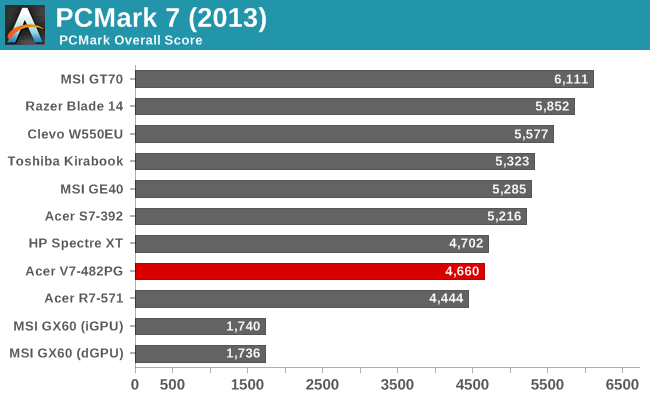
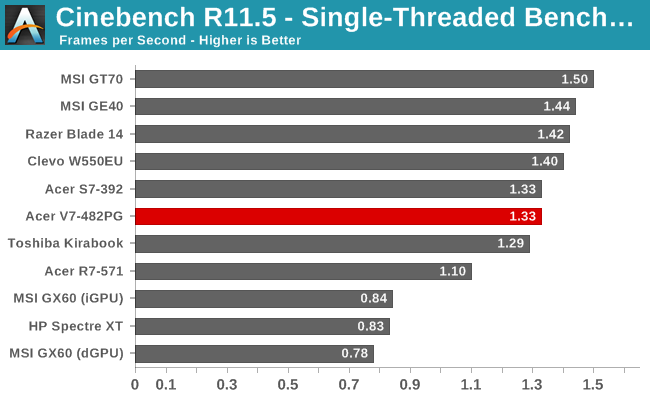
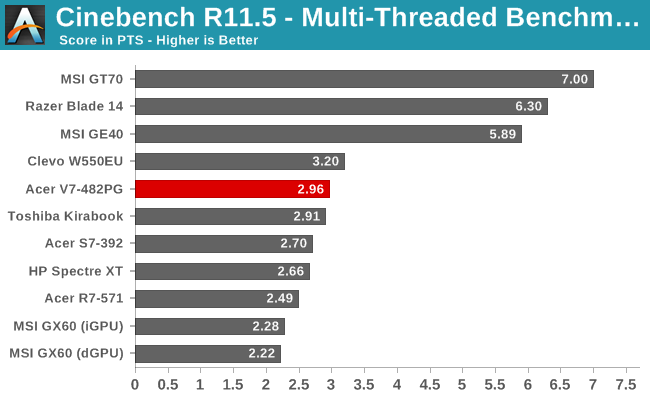
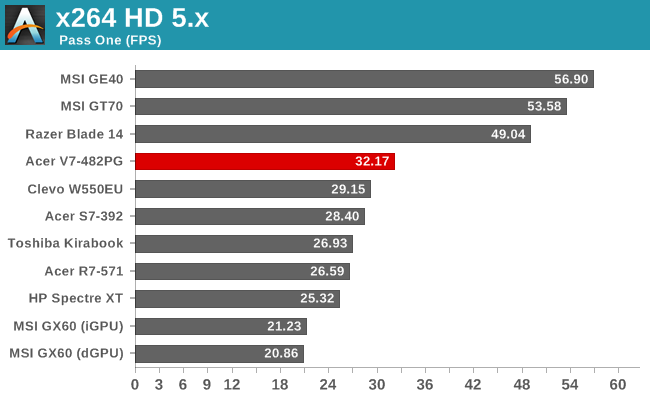

Starting as usual with PCMark 7, obviously the MSI GX60 is seriously penalized by not having a solid state drive. The rest of the systems all come together, with quad-core SSD systems at the top, followed by the dual-core SSD systems, and bringing up the rear we have hybrid SSD + HDD laptops like the Aspire V7. Personally, I find that hybrid storage feels a little closer to pure HDD than it does pure SSD, and benchmarks like PCMark 7 tend to paint a rosier picture than reality. Still, hybrid storage is far better than not having any solid state storage at all. For general use, the fact is that just about any modern system is more than fast enough – and other than a few specific use cases, a solid state drive doesn’t make your system two or three times faster, but it’s still definitely something I want to have in any modern system.
Our next set of performance benchmarks put more of the strain on the CPU, and here we see something that most of us already expected: Haswell isn’t substantially faster than Ivy Bridge. It seems like cooling and thermal throttling (or in other words, bios and firmware optimizations) can have a larger impact on performance than the choice of CPU. For example, the Toshiba KIRAbook and HP Spectre XT have virtually the same Core i7 Ivy Bridge CPU, but the Spectre XT ends up being substantially slower. In terms of where Haswell sits, the i7-4500U comes out ahead of all of the Core i7 ULV Ivy Bridge CPUs, but the difference ranges from a negligible 2-3% in Cinebench to a slightly more noteworthy 8-20% in x264 HD. How much of the difference in x264 is from IPC improvements and how much of it is just a question of BIOS/firmware differences is difficult to say – keep in mind that the Acer S7-392 has the same CPU, so firmware is probably the bigger factor.
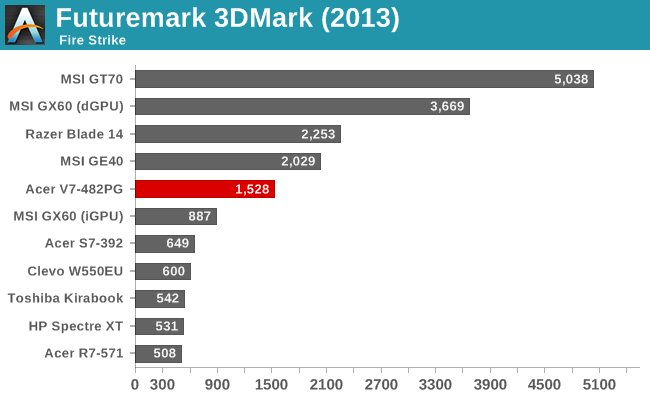
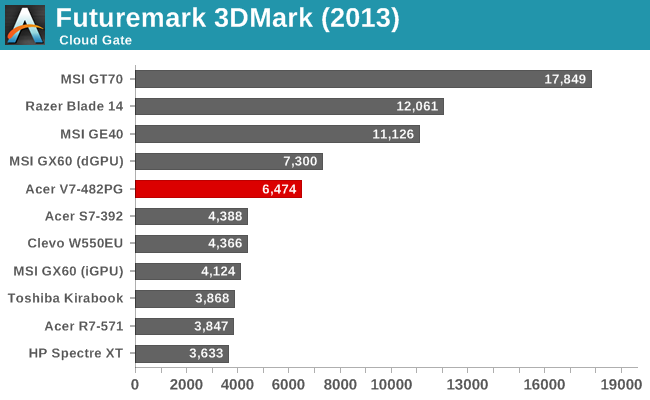
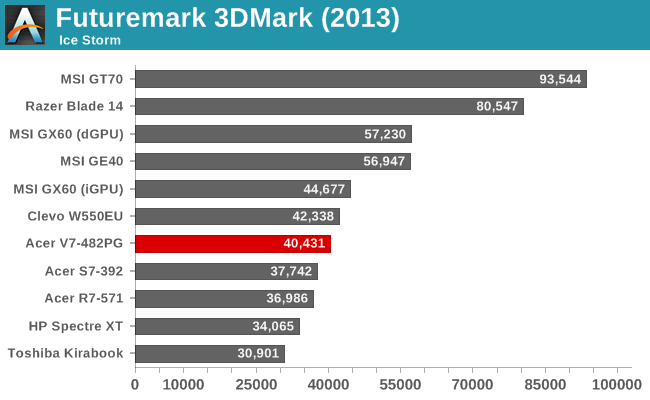
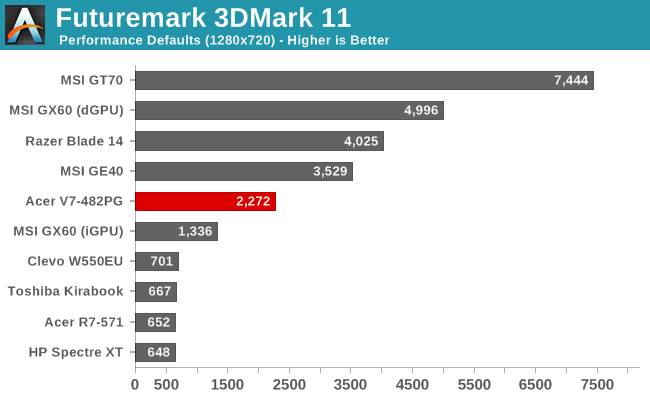
In terms of graphics performance, using 3DMark as our baseline estimate, there’s clearly a pecking order established: high-end GTX and HD 7900 GPUs, moderate GTX 760 GPUs, the GT 750M used in the V7, AMD’s Richland/Trinity iGPU, and then all of the Intel integrated graphics solutions. I’m still surprised that the GT2 implementations of Haswell haven’t really improved over the GT2 Ivy Bridge iGPU, but variations in clock speed certainly play a role. We should also be getting our first Crystalwell (Haswell GT3e) laptop in the next week, which of course will improve performance quite a bit but at a pretty hefty price. Depending on how much OEMs have to pay NVIDIA for something like the GT 750M, and considering the lack of GT3e on dual-core parts, I suspect we might end up waiting for Broadwell for a truly compelling mainstream iGPU from Intel.
And with that said, let’s move on to gaming benchmarks.










62 Comments
View All Comments
damianrobertjones - Tuesday, August 27, 2013 - link
"I’m frequently amazed at how much better battery life is with Apple hardware under OS X" - I didn't see this in the last gen of macbooksI hope that this machine, as well as the Sony, is mentioned in future battery sections as the Mac DOES NOT PROVIDE the best battery life.
http://www.pcpro.co.uk/reviews/laptops/383785/dell...
JarredWalton - Tuesday, August 27, 2013 - link
Their "Light" battery test is not the same test that we use, nor is it at the same brightness setting. The MacBook Air 13 Haswell model gets 11.03 hours while loading four web pages every 60 seconds with the LCD at ~200 nits. They measured 12.68 hours of battery life doing what? "The light-use test is the absolute longest you can expect the battery to last with careful power management." That sounds like they're doing nothing, equivalent to our old "Idle" battery life testing from last year, and possibly at minimum brightness.We haven't been doing Idle testing for 2013, but on laptops tested previously idle battery life was typically 20% to as much as 40% more than what we got on our Internet testing. Our new Light test is our old Internet test with the LCD at 200 nits, so basically take the MBA13 result and multiply by at least 1.2 to be fair, and possibly as much as 1.4. That means the MBA13 under OS X while idle could easily hit 15+ hours, which would be more than any Windows laptop manages with a similar size battery.
Basically, you have to make sure you're comparing apples to apples when it comes to battery life testing. If a site doesn't completely document how they're testing, you can't do that.
willstay - Wednesday, August 28, 2013 - link
"Anand didn’t test Windows battery life with the new MBA13" - I wish he did. No one has done it with MBA13 yet.ihleonard - Saturday, August 31, 2013 - link
Since these don't seem to be available/on display in store anywhere, I want to get some idea of what they feel like before I take the plunge and get one. Are there any Acers (or other laptops) with a similar keyboard feel that are widely available in store; I just want to make sure that the low travel is ok.Thanks
Otunia - Monday, September 2, 2013 - link
This PC shows why 16:9 screens are bad. I'm writing this comment on an old 16:10 laptop which is as wide as this new Acer and guess? My screen is 15" thanks to all those extra vertical pixels.There are two extra downsides of this PC: the memory limit at 12 GB (why not two 8+8 GB unsoldered slots? For the extra thinness? Who cares!) and the glossy screen. So even if the keyboard and the touchpad turn to be super we are left with a subpar screen and constrained memory. The rotational disk would be OK if it can be upgraded later on.
A good attempt but please try again. Hint: just clone the 16:10 matte MBP 15" and perfect it by letting people upgrade its parts.
Hrel - Tuesday, September 3, 2013 - link
While I'm sure Microsoft is pushing for manufacturers to include touchscreens; it adds NO value right now. So the problem then becomes, if you include a touchscreen you can't charge for it. Which means reduced margins. I'm certainly not going to pay for it. This thing is at least $100 too expensive.Looks like a good machine though, if I could find it on sale for 1K I'd probably buy it.
ziotoo - Sunday, September 8, 2013 - link
Hey jared (or any v7 owner)My laptop died and thought of upgrading to the acer v7
The question is: i do design on my laptop, both 2d (photoshop, vectorial, animation, video editing) as well as 3d (from cad to maya/max). This is the first mainstream laptop i see with a decent dedicated graphic solution, and since i also do photo retouching you pretty much sold me on the screen. I travel a lot and the v7 is light and has the perfect screen format for me. It's also 1000eur in europe, wich is a really good price for this kind of product.
The problem is the i5 cpu. I've had a first gen i7 (i think 720 qm) quad core cpu for the past years and it was enough for me. But i'm scared that the acer v7 will actually offer worse performance with its 4th gen dual core i5 than my old laptop. Am i right to be worried? And would an i7 4500u actually be much better, even though that's also a dual core? It's gettong very hard to find quad core cpus in the 2kg weight range.
Thanks a lot.
ziotoo - Sunday, September 8, 2013 - link
Forgot to add: the 14 inch configuration in europe only sports an i5. The rest is unchangedhellermercer - Friday, November 22, 2013 - link
I need powerfull speakers!!!!hellermercer - Friday, November 22, 2013 - link
I need powerfull speakers!!!!